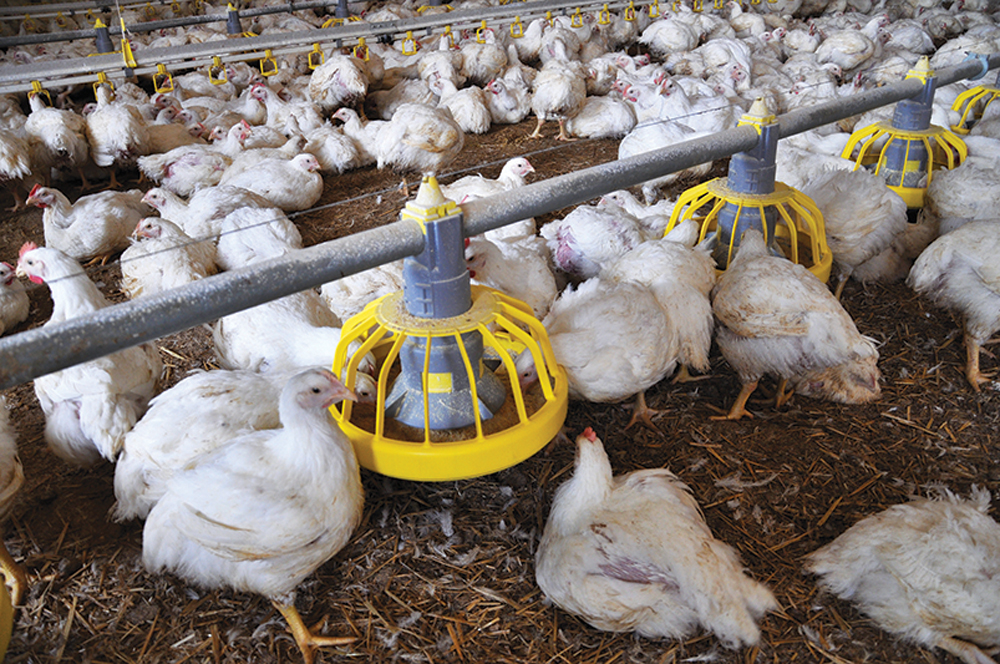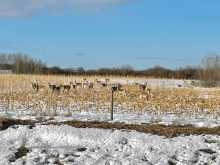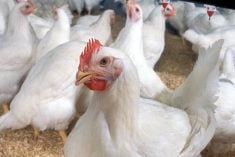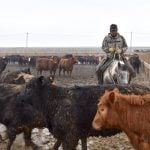Glacier FarmMedia – The spring run of highly pathogenic avian influenza (HPAI) has started in some parts of the country.
But a year of experience managing the disease has Canadian farmers ready with new knowledge and tools.
From the start of March to April 5, officials had confirmed three cases in domestic poultry operations in Ontario, four in a single region of Quebec and one in Nova Scotia. Provinces have also reported numerous suspected and confirmed deaths in wild birds due to the virus.
Read Also

Three paths of rengerative agriculture
From integrating livestock to grassland financial incentives to precision grazing, Canadian farmers are searching for practical paths to marry farm resilience with profit
Why it matters: Avian flu affected many farms across Canada in 2022, and wild birds and their migratory patterns were an important disease vector.
The Canadian Food Inspection Agency is convening weekly meetings of the industry to pass on information and respond to questions. The first meeting lasted slightly more than five minutes, but that doesn’t mean it’s status quo in response to what is being described as Wave 3 of this avian influenza pandemic.
Last year, the virus led to serious losses in North America’s feather sectors, wiping out 50.54 million farm birds in the United States as of early December. In Canada, outbreaks since late 2021 had affected more than three million farm birds by October of last year. Another 99 cases followed over the winter, including a B.C. outbreak that racked up 75 infected premises from November 2022 to March 2023 and caused headaches in major poultry-producing areas such as Chilliwack.
As of March 29, Canada had lost more than 7.2 million domestic birds either to the disease or control measures to prevent its spread.

“We’ve never had anything like this in Canada, and perhaps anything like this across the globe,” said Dr. Shayan Sharif, acting dean of the University of Guelph-based Ontario Veterinary College.
Sharif has specialized for 15 years in viral immunology related to domestic poultry influenza. He confirmed in an interview that the CFIA is justified in its heightened vigilance about the current strain since it arrived in Atlantic Canada on migratory birds over a year ago.
But he said vigilance and enhanced biosecurity to limit spread once outbreaks are identified are only “the first step” in what should be a stronger response strategy, and it’s time to put more resources into vaccine readiness.
“This strain of the virus (H5N1) may or may not stick around,” he said. “It may go away. But if it does, it will not be the last time we see a highly pathogenic strain like this. And the next time around, it might stick around longer,” be even more readily transmissible, and spread to more species, including humans. That could happen with this strain, he added, “and we’re not prepared.”
Wave 3, corresponding with the third wild bird migration period since HPAI arrived in Canada, first hit Canada on March 4 in Nova Scotia. That case was followed by a backyard flock infection in southwestern Ontario on March 10.
CFIA industry lead Tori Wilson chaired the March 22 online information session and said destruction and disposal of that Ontario flock is complete.
Days later, the first commercial flock fell prey to the third wave. HPAI was confirmed on March 14 on a commercial farm in Ontario’s Niagara region. That flock has been destroyed but not yet disposed of, officials said.
Sharif said the industry is at the start of a 2023 outbreak that will most likely rival 2022. Mass die-offs of as many as 100 waterfowl have already been reported in several urban jurisdictions and “I do believe there will be more farms becoming infected very soon.”
The Feather Board Command Centre co-hosts the Ontario version of the CFIA information sessions. Similar models have been set up in other provinces.
During the first 2023 information session, with dozens of online participants, only one question was asked: If a barn gets infected, how long would it take before it could be repopulated by pullets? CFIA veterinarian Dr. Ellen Denstedt said it ranged between three and eight months.

Steps to manage infection
The first step is destruction of the infected birds, Denstedt said, and this can take “a couple of days to work out the logistics” if it’s a larger flock and gassing the facility is necessary. “We’re kind of at the mercy of the gas suppliers if an outbreak occurs.”
Dead birds must then be destroyed.
A shorter time span of six weeks before repopulation might be possible if it’s a single-building facility with a single air space instead of several floors, but that’s likely a too-tight timeline, she added.
Strategies to quickly repopulate barns are not the main focus for the veterinary college’s acting dean. Sharif said this strain of HPAI is much different from previous ones.
More transmissible
“In the past, we’ve had highly pathogenic strains of AI in Canada,” he said, citing a 2004 outbreak in British Columbia and a 2014 strain that spread to domestic flocks in B.C. and Ontario. “But the extent and breadth of those outbreaks were limited.”
In contrast, this strain is much more transmissible between birds of the same species and can also be readily spread to other species of birds and, increasingly, mammals, he said.
That includes birds previously thought to be unaffected, including eagles, vultures and waterfowl that were thought to have the virus but show no symptoms.
“If you open any textbook about poultry diseases and look up avian influenza, you would see waterfowl listed as reservoirs of avian influenza viruses,” said Sharif. “That means they get (the disease) and spread it but it doesn’t affect them.”
In mammals, B.C. recently reported a group of skunks that died from the disease. Internationally, sea lion populations along the coastline of Peru are affected. There’s uncertainty about whether those marine mammals spread the disease among their own species or catch it from an infected marine bird population.
In Spain, a recent report confirms this strain of HPAI has jumped from mammal to mammal among an infected population of farmed mink.
A page linked to the CFIA website tracks suspected and confirmed HPAI cases in wildlife based on deaths reported to and investigated by the Canadian Wildlife Health Cooperative. It shows confirmed 2023 deaths throughout much of agro-Manitoba.
Food safety message important
“It is important to remember that there is no food safety risk or evidence to suggest that the virus can be transmitted to humans through food consumption,” said command centre incident commander Dr. Harold Kloeze in an agency statement.
“Canadian poultry products are safe to eat and continuing to buy them is the best way to support poultry farmers and industry.”
Humans who come in contact with infected animals can contract this strain of HPAI, but there are no confirmed Canadian cases.
During a recent media briefing, World Health Organization chief scientist Jeremy Farrar said he would like countries to develop or secure supplies of vaccines for all influenza viruses now circulating in the animal world.
“My concern is that we’re in slow motion watching something which may never happen,” said Farrar, as quoted in a recent Reuters article. “But if it were to happen, would we look back on what we’re doing at the moment and say, ‘why didn’t we do more?’”
Time for strategy?
France’s agriculture minister told Reuters the nation may follow the leads of Mexico and Ecuador by implementing mass vaccination of domestic poultry. Sharif said Canada should expand its HPAI response strategy so it could make a similar move if necessary.
Avian influenza vaccines have been approved and can be made available on an emergency basis to poultry producers in the United States, noted Sharif. At the least, he would like to see Canadian producers have the same option.
As with human flu vaccines, the available products may not be highly effective against evolving HPAI strains, he added. But putting more resources toward vaccine development in Canada now should make it more likely that an effective vaccine could be created quickly once a new strain is detected.
Sharif said if a vaccination program were added to the HPAI response strategy, he would suggest targeting specific populations rather than a mass administration to all domestic poultry.
Poultry vaccines are typically administered through water, sprayed onto flocks, injected into live birds or injected into hatching eggs. Sharif said an HPAI vaccine would likely be water-based or sprayed.
Biosecurity reminders
Poultry sector officials say biosecurity protocols for poultry farms will be an important part of keeping the disease in check. Producers should:
- Keep poultry away from areas frequented by wild birds.
- Maintain strict control over access to poultry houses and premises.
- Make sure equipment is cleaned and disinfected before taking it into poultry houses.
- Do not keep bird feeders or create duck ponds close to poultry barns.
- Maintain the highest sanitation standards.
- Change footwear when entering the restricted area and prevent wearing contaminated clothing and equipment in production areas.
- Control access to the farm site by communicating the situation to all essential visitors, including service providers, input suppliers and feed providers.
- Keep mortalities in secure, covered containers until they are moved to the disposal area or taken off-farm.
- Place a hose and spray nozzle at the entry point to controlled access zone; wash and disinfect vehicles at entry and at exit, paying special attention to wheels and wheel wells.
If birds show any signs of illness, call a veterinarian immediately.
– This article was originally published at Farmtario.















